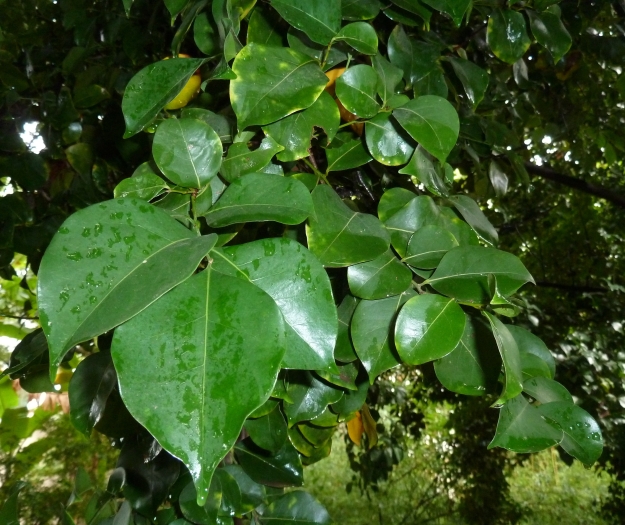Cape Quince
(Cryptocarya woodii)
Cape Quince (Cryptocarya woodii)
/
/

JMK
CC BY-SA 3.0
Image By:
JMK
Recorded By:
Copyright:
CC BY-SA 3.0
Copyright Notice:
Photo by: JMK | License Type: CC BY-SA 3.0 | License URL: https://creativecommons.org/licenses/by-sa/3.0 | Uploader: JMK | Publisher: Wikimedia Commons | Title: Cryptocarya_woodii,_loof,_a,_Manie_van_der_Schijff_BT.jpg | Notes: User created page with UploadWizard |










Estimated Native Range
Summary
Cryptocarya woodii, commonly known as Cape Quince, is an evergreen tree native to the moist forest margins, riverine woodlands, and coastal forests of Southern Africa. It typically grows to a height of 15-30 feet (5-9 meters) and a width of 10-20 feet (3-6.1 meters), with a dense, rounded canopy. The leaves are glossy and dark green, with the distinctive secretory glands visible when held against light. From mid-summer, it produces small, yellow, and somewhat inconspicuous flowers, followed by shiny, purple-black fruits with a bumpy surface that are attractive to birds.
Cape Quince is valued for its lush foliage and the shade it provides. It is suitable for urban planting, as a specimen tree, or for creating privacy screens in residential gardens. It is relatively low-maintenance, tolerating both full sun and part shade, and requires low amounts of water once established. The tree prefers soils with medium drainage. While it is not commonly affected by diseases, it can be susceptible to root rot if overwatered. It is not known for aggressive roots or invasiveness, making it a safe choice for gardens.CC BY-SA 4.0
Cape Quince is valued for its lush foliage and the shade it provides. It is suitable for urban planting, as a specimen tree, or for creating privacy screens in residential gardens. It is relatively low-maintenance, tolerating both full sun and part shade, and requires low amounts of water once established. The tree prefers soils with medium drainage. While it is not commonly affected by diseases, it can be susceptible to root rot if overwatered. It is not known for aggressive roots or invasiveness, making it a safe choice for gardens.CC BY-SA 4.0
Plant Description
- Plant Type: Tree
- Height: 15-30 feet
- Width: 10-20 feet
- Growth Rate: Moderate
- Flower Color: N/A
- Flowering Season: Summer
- Leaf Retention: Evergreen
Growth Requirements
- Sun: Full Sun, Part Shade
- Water: Medium, High
- Drainage: Medium
Common Uses
Drought Tolerant, Low Maintenance
Natural Habitat
Moist forest margins, riverine woodlands, and coastal forests
Other Names
Common Names: Bastard Camphor Tree
Scientific Names: , Cryptocarya woodii, Cryptocarya acuminata,
GBIF Accepted Name: Cryptocarya woodii Engl.